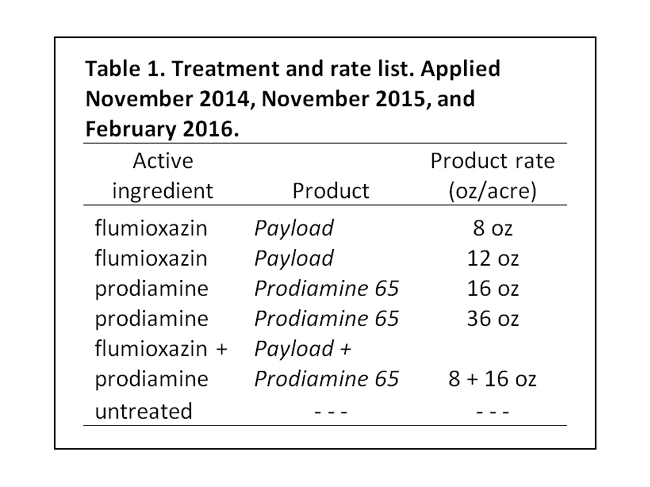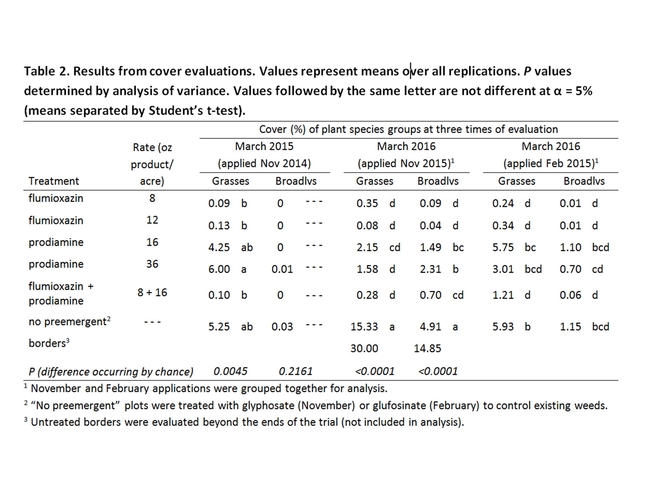Solano Irrigation District (SID) delivers water to 37,000 acres of farmland through an extensive network oflined canals, pipelines, and unlined irrigation and drainage canals. The unlined canals are typically drained at the end of the water delivery season in October and remain dry until spring. During dewatering, winter annual weeds can germinate in the unlined canals and grow until the canals are refilled with water. During the irrigation season, the weedy leftovers clog up control gates, meters, and irrigation equipment. To minimize flow reductions and equipment interference, SID must manage winter weeds through mechanical removal or herbicide application.
Mechanical weed removal is expensive and requires specialized equipment. Herbicides for dry canals should have some preemergence activity so that repeated applications aren't needed, but the few pre herbicides labeled for such use are either not labeled for annual weeds or have restrictions on their use.
Flumioxazin (Payload, Chateau, Sureguard) is registered in California for bare ground, aquatic, ornamental, and agricultural uses. It has preemergent and early postemergent activity against a broad spectrum of annual broadleaf and grassy weeds. It has a relatively short soil half-life and degrades rapidly in water, especially under alkaline conditions. These features make flumioxazin well suited for management of weeds in dewatered canals and similar sites with seasonal water. However, prior to this study this chemical was not registered for this use.
To test the efficacy of flumioxazin in a typical dewatered canal application, we established trials (2014-15 and 2015-16) comparing flumioxazin treatments with untreated plots and with prodiamine, an herbicide previously used by SID. Treatments were applied to plots in a dewatered canal running due north-south. The canal was drained in mid-October and was dry at the time of treatment. In November 2014, we applied six treatments in four randomized complete blocks for a total of 24 plots (Table 1). Plots were 30 ft wide (topographic width of the canal) by 48 ft long. Total length of the trial was 1152 ft. In November 2015, we repeated these treatments (different location) and repeated the treatments again in February 2016, ~ 60 days before the canal was refilled. This trial had a total of 48 plots (6 treatments, 4 reps, 2 timings); plots were 36 ft long for a total length of 1728 ft.
We controlled already-emerged weeds with glyphosate or glufosinate. Treatments were applied in 40 GPA spray solution using a CO2 backpack sprayer and a 6-nozzle boom. Each plot was treated in 3 passes of 10-ft swaths, one pass for each bank and one for the bottom of the canal.
Italian ryegrass (Lolium multiflorum) was the dominant weed present. This weed is of particular concern because glyphosate-resistant biotypes are common in our area. We saw a few other grass species and 13 broadleaf species, most with much less cover than ryegrass.
In evaluations conducted shortly before the refilling of the canal, plots treated with flumioxazin at both rates, both years, and both timings in the second year had less than 0.5% total weed cover, including both grasses and broadleaves (Table 2). Plots treated with flumioxazin + prodiamine were more variable but still had, at worst, less than 1.3% cover. By contrast, plots treated with only prodiamine had approximately 4% to 6% weed cover, mostly Italian ryegrass, and plots with no preemergence treatment had 5% to 15% cover. Untreated areas outside the trial had about 45% cover.
In summary, applications of flumioxazin, even at the low rate tested, gave 3 to 4 months of residual weed control at a level which irrigation district representatives found acceptable. Another chemical previously in common use in this irrigation district, prodiamine, did not provide acceptable control. Based on these study findings, California DPR approved a special local needs (24c) registration for flumioxazin in dewatered canals.
Attached Images:


